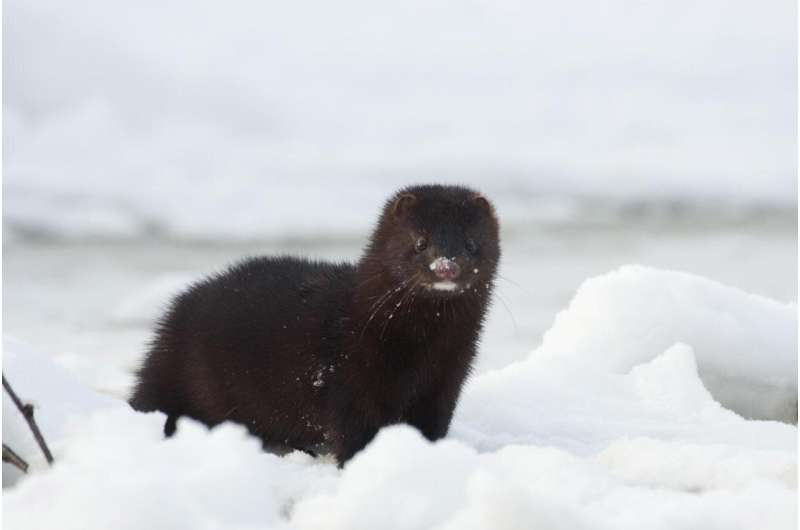American mink regrow their brains in a rare reversal of the domestication process

Farm animals look different from their wild counterparts in many ways, and one difference is consistent: their brains are smaller than those of their ancestors. From sheep to pigs to cows, domesticated animals have smaller relative brain sizes compared to their wild counterparts—a phenomenon known as the domestication effect.
Now, a study by the Max Planck Institute of Animal Behavior (MPI-AB) has discovered a rare reversal of the domestication effect. Over the course of captive breeding, the American mink has undergone a reduction in relative brain size, but populations that escaped from captivity were able to regain almost the full ancestral brain size within 50 generations. The study is published today in the Royal Society Open Science.
“Our results show that loss of brain size is not permanent in domesticated animals,” says Ann-Kathrin Pohle, a Master’s student at MPI-AB and first author on the paper. “This finding deepens our understanding of how domestication has changed the brains of animals, and how these changes might be affecting animals when they return to the wild.”
Understanding the feral brain
When animals lose brain size through the course of domestication, it’s mostly considered to be a one-way street. Animals almost never seem to regain the relative brain sizes of their ancestral forms, even in feral populations that have been living in the wild for generations. “Once animals loose parts of their body, such as certain brain regions, over the course of evolution, they are gone and cannot simply be regained,” says Dina Dechmann, senior author on the paper, and a group leader at MPI-AB.
Studying whether or not feral animals can regain the relative brain sizes of their wild counterparts is also difficult methodologically. To properly do so, Dechmann says, “you would need to find an animal with separate wild and feral populations to reduce the chance that the groups had mixed. And, you would need to find an animal that could be studied through sufficient brain and skull measurements.” You would need an animal, in other words, like the American mink.
Native to North America, the American mink has been domesticated for the fur trade for over a century. After they were bred in Europe for fur farming, captive animals escaped to form feral populations that have spread throughout Europe. This natural history thus provided the separated populations that Dechmann and her team needed: wild mink from North America, domesticated mink from European fur farms, and feral mink from Europe.
To explore changes in brain size, the team turned to a proxy: skulls. “Braincase size is a good proxy for brain size in mink, and this allows us to take measurements from existing skull collections without the need for living animals,” says Pohle. A museum collection from Cornell University was used to study skulls of wild American mink while European fur farms provided skulls of domesticated animals.
For the feral population, Dechmann and Pohl collaborated with Andrzej Zalewski at the Polish Mammal Research Centre who had a collection of skulls obtained from an eradication program of feral mink. “Usually, the difficulty with skull studies is finding big enough collections to work with,” says Dechmann. “We were incredibly fortunate to work with multiple organizations to obtain the population samples we needed.”
The team took measurements from skulls to calculate relative brain size of the animals. They found that, according to the well-documented domestication process, the brains of captive-bred mink had shrunk by 25% compared to their wild ancestors. But, in contrast to expectations, the brains of feral mink grew almost back to wild size within 50 generations.
Flexible brains
Dechmann suspects she knows why this animal, in particular, has achieved what was thought to be unlikely. American mink belong to a family of small mammals with a remarkable ability to seasonally change their brain size in a process known as Dehnel’s phenomenon. Dechmann, an expert on this process, has documented Dehnel’s in shrews, moles, and weasels.
“While other domesticated animals seem to lose brain size permanently, it’s possible that mink can regain their ancestral brain sizes because they have flexible brain size built into their system,” she says.
This flexibility could have offered advantages to the mink that re-entered the wild. “If you escape from captivity back to nature, you would want a fully capable brain to navigate the challenges of living in the wild. Animals with flexible brains, like the mink, could restore their brains even if they had shrunk it during an earlier time.”
The results don’t reveal if the brains of feral mink function the same as wild type mink. To find that out, the team would have to examine the brains of animals, which is a step for a future study.
More information:
Ann-Kathrin Pohle et al, Domestication effect of reduced brain size is reverted when mink become feral, Royal Society Open Science (2023). DOI: 10.1098/rsos.230463
Citation:
American mink regrow their brains in a rare reversal of the domestication process (2023, July 5)
retrieved 5 July 2023
from https://phys.org/news/2023-07-american-mink-regrow-brains-rare.html
This document is subject to copyright. Apart from any fair dealing for the purpose of private study or research, no
part may be reproduced without the written permission. The content is provided for information purposes only.
For all the latest Science News Click Here
For the latest news and updates, follow us on Google News.

